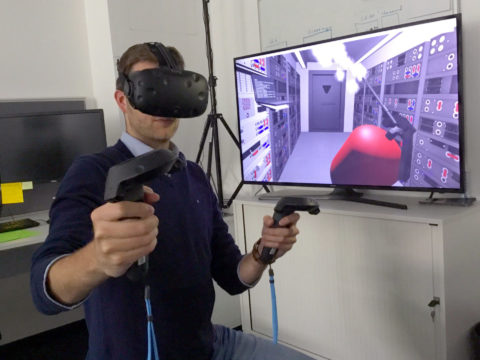
On November 16, 2021 the U.S. Food and Drug Administration (FDA) announced that it had authorized marketing of EaseVRx, which they described as “a prescription-use immersive virtual reality (VR) system that uses cognitive behavioral therapy and other behavioral methods to help with pain reduction in patients 18 years of age and older with diagnosed chronic lower back pain”. Virtual reality has been proposed as therapy for other health conditions, and this is a good opportunity to review the evidence.
Virtual reality creates the illusion of a different world, which may be something like the real world or completely different. Usually involving a headset, it allows users to look around the artificial world, move around in it, and interact with it. Viewers of America’s Funniest Home Videos and YouTube will be familiar with it from watching videos where people wearing a VR headset lose awareness of their surroundings and react as if the artificial world were the real one. They suffer from falls, frights, and other mishaps, sometimes only making themselves and others laugh but sometimes causing damage to self, other people, and property.
The study the FDA based its approval on was a double-blind randomized controlled study of 179 individuals with chronic low back pain. The treatment program consisted of 56 VR sessions lasting 2-16 minutes, incorporating established principles of behavioral therapy in a skills-based program. These principles included “deep relaxation, attention-shifting, interoceptive awareness–the ability to identify, access, understand and respond appropriately to the patterns of internal signals—and perspective-taking, distraction, immersive enjoyment, self-compassion, healthy movement, acceptance, visualization, knowledge of pain and rehabilitation”. All subjects were issued a headset with a “Breathing Amplifier” device to facilitate breathing exercises. No serious adverse effects were reported, but 20.8% of participants reported discomfort with the headset and 9.7% reported motion sickness and nausea.
66% of EaseVRx participants reported a greater than 30% reduction in pain, compared to 41% of control participants who reported a greater than 30% reduction in pain. Results were self-reported, with an average decrease in pain intensity of 1.31 points on a 10-point scale, which doesn’t seem very impressive.
I found their choice of a control group puzzling and disturbing. They compared the full 3D experience involving a skills-based program of established principles to a 2D experience with pleasant images and no skills-based program. Is that an appropriate control group? I don’t think so! It leaves me suspecting that the positive results might have had nothing to do with VR and everything to do with the skills-based program.
Virtual reality has been used for other medical applications, such as exposure therapy for anxiety, phobias, and PTSD. There are many different virtual reality programs. It would have been more useful to compare different virtual realities to see which ones were most effective to relieve pain. I can’t imagine that a virtual world designed to desensitize patients to threats like spiders or combat would be as effective for pain as a world of pleasant images designed to relax and distract from pain, like a sunny day at the beach.
VR is not harmless. Virtual reality sickness, similar to motion sickness, occurs in many users; women are more susceptible than men. Indeed, it affected 9.7% of participants in the study in question. Concerns have been raised about possible adverse effects for children.
VR has been used for training, rehabilitation, addiction, and to treat many specific health conditions – everything from cerebral palsy to eating disorders. It may be used alone or as an adjunct to other treatments. Systematic reviews have not been very convincing, and they all call for more studies.
Using VR for pain makes sense. Anything that distracts the patient’s attention from the pain tends to decrease the perception of the pain. That’s essentially why parents kiss their children’s owies.
Conclusion: VR has many valid uses, and distraction is effective for pain
While I cannot understand why the FDA relied on a study with no valid control group, I applaud their approval of EaseVRx. As with eye movement desensitization and reprocessing (EMDR) it may be no more than a gimmick to enlist the patient’s cooperation with effective treatments like cognitive behavioral therapy (CBT). If a gimmick is needed to get a patient to accept proven techniques of behavioral therapy, isn’t that worthwhile?

